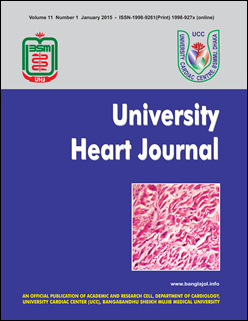Socio-Demographic Characteristics of Patients Presenting to the Vascular Emergency Department of National Institute of Cardiovascular Diseases (NICVD)
DOI:
https://doi.org/10.3329/uhj.v11i1.27592Keywords:
Emergency department, vascular surgery, National Institute of Cardiovascular Diseases (NICVD)Abstract
Emergency department of vascular surgery of National Institute of Cardiovascular Diseases (NICVD) is rendering service for the patients suffering from vascular trauma since 2001. Data regarding this practice of emergency services is rarely published. This paper aims to provide the epidemiological characteristics of patients presenting the vascular emergency department of NICVD between 01/9/14 to 30/09/14. This study is intended to benefit the policy makers, healthcare providers in Bangladesh to promote and define the specialty of emergency vascular department and to allocate resources more effectively to address countrys acute care needs. In total sixty four (64) patients was attended in this 1 month. The male to female ratio was 60:4 with age range from nine to sixty four years (mean age 30.8years). Among them thirty nine percent patients belong to low socioeconomic class, thirty one percent from middle class and others from affluent family. Forty patients (62.5%) were referred from various institute of Dhaka city and rest from outside Dhaka. Seventy five percent patients came by ambulance, eight percent by private vehicles and rest by other means. Fifty eight patients (90.62%) came with referral papers from other health institutes, where there is no vascular surgery department. Most common cause of referral was vascular trauma (78.12%), other causes of referral were complicate vascular aneurysm (7.8%) and vascular thrombosis (14.06%). The time since injury and seeking treatment for vascular surgery ranged two hours to six days. Mean time was 10.3 hours. Forty cases (62.5%) sustained vascular trauma by accident with sharp cutting objects during occupational and house hold activities, assault (stab injury, blunt injury and gunshot) ten cases (15.62%), road traffic accident seven cases (10.93%), intravenous drug abusers three cases (4.68%), accidentally fall from height three cases (4.68%) and post operative complication one cases (1.56%). This study demonstrates that eighty eight percent study populations presented with arterial injuries and only twelve percent with venous injuries. Associated injuries (tendon, nerve, muscle, fracture of bones and joints dislocation) were present in fifty six patients (87.5%). Most common artery that was injured was radial artery. Vascular Injuries were treated with end to end anastomosis in twenty five patients (36.6%), ligation of vessels in twenty three patients (35.9%), fasciotomy was done in eight patients (12.5%) , embolectomy (fogerty) was done in four patients (6.25%) ,. aneurysmectomy was needed in two patients (3.1%) and interposition venous graft was used in two cases (3%). The emergency department of vascular surgery of National Institute of Cardiovascular Diseases (NICVD) is taking the entire burden with their small resources to ensure the best quality care for the management of the patients with vascular injuries. The data can inform and guide the allocation of national resources towards emergency care, injury prevention campaigns, emergency service evaluation and clinical guideline development.
University Heart Journal Vol. 11, No. 1, January 2015; 3-6
Downloads
217
243

